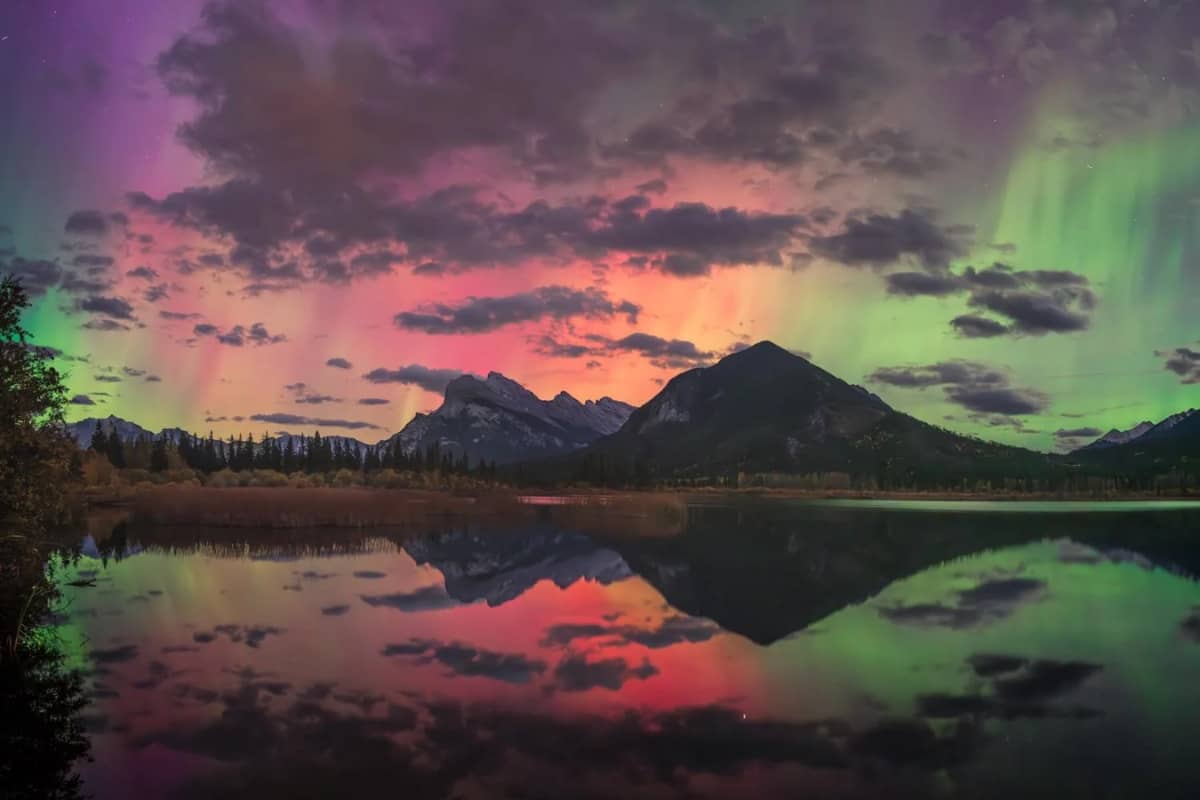Experiencing the northern lights at Vermilion Lakes is a breathtaking adventure, but it also comes with some hidden dangers. While the aurora borealis is a mesmerizing natural phenomenon, the remote and wild nature of Vermilion Lakes, combined with the challenging winter conditions, can pose several risks. This article explores the hidden dangers one might encounter when venturing to Vermilion Lakes for aurora viewing and provides essential tips on how to stay safe.
Extreme Cold and Hypothermia Risks
The first significant danger in witnessing the northern lights at Vermilion Lakes is the extreme cold. Situated in Banff National Park, Vermilion Lakes experiences harsh winter conditions, especially during the peak months for aurora viewing. Temperatures can plummet well below freezing at night, often reaching dangerous levels of cold. Those who venture out without adequate preparation may face hypothermia, frostbite, or other cold-related conditions.
Staying warm in this environment requires careful planning. Layers of thermal clothing, windproof jackets, and insulated gloves and hats are essential. A common mistake is underestimating the cold when focusing on the spectacle in the sky. Prolonged exposure without proper clothing can lead to hypothermia, where the body loses heat faster than it can produce, posing serious health risks.
Wildlife Encounters at Night
Another hidden danger at Vermilion Lakes comes from wildlife, particularly during the night. Banff National Park is home to a variety of large mammals, including elk, deer, and bears. At night, these animals are more active, and human encounters can be unpredictable and dangerous. While sightings can be rare in the cold months, there have been instances where aurora viewers have inadvertently startled wildlife. Bears, though often hibernating during the winter months, can still pose a threat if they are disturbed.
Additionally, elk and deer roam freely, and though these animals generally avoid human interaction, a close encounter in low visibility conditions can be hazardous. To avoid such situations, it’s crucial to stick to designated paths and avoid wandering into more secluded areas
Slippery Terrain and Icy Conditions
Winter in the Canadian Rockies brings ice and snow, making the terrain around Vermilion Lakes treacherous. Slippery roads, ice-covered trails, and frozen lakes are all potential hazards. One of the biggest dangers is slipping on ice, which can lead to serious injury, especially in such a remote location. Aurora hunters should be cautious when walking on trails or frozen sections of the lakes.
It is recommended to wear proper footwear with good traction, such as snow boots with ice grips, to prevent slipping. Some trails may be closed due to hazardous conditions, so checking local reports before heading out is crucial.
Another hazard comes from driving on icy roads. Vermilion Lakes Road can become dangerously slick in winter, making it easy to lose control of a vehicle. Keeping speed low, ensuring tires are suitable for winter driving, and carrying emergency supplies are all necessary precautions.
Light Pollution and Crowds
Although Vermilion Lakes is one of the better places to see the aurora borealis, it has become increasingly popular. This surge in popularity has brought new risks. Crowded conditions during prime aurora viewing periods can lead to light pollution from car headlights, flashlights, and camera equipment, which can detract from the experience. Worse, crowded viewing spots can create parking issues, making navigation tricky.
Ensuring you park in designated areas and turn off all unnecessary lights will reduce your contribution to the light pollution and help create a more enjoyable experience for everyone. Moreover, crowded areas increase the risk of accidents, particularly on narrow, icy roads.
Fatigue and Exhaustion
One of the less obvious dangers of aurora hunting is the physical and mental fatigue that can set in after long hours of waiting in the cold. The northern lights can be unpredictable, sometimes requiring hours of waiting in freezing temperatures. This extended exposure, coupled with late-night hours, can lead to exhaustion, impairing decision-making and reaction times.
It’s essential to pace yourself and take breaks. Packing snacks and hot drinks can help you maintain your energy and warmth. Thermos flasks with hot beverages like tea or hot chocolate are highly recommended. In addition, bringing calorie-dense snacks will help fuel your body in the cold environment.
Frozen Lakes and Thin Ice
One of the most picturesque aspects of the Vermilion Lakes is their glassy, reflective surface, which beautifully captures the dancing lights of the aurora. However, this surface can also be deceptive. Frozen lakes may seem stable, but ice thickness can vary significantly depending on weather conditions. Venturing onto thin ice can lead to falls and even drowning.
To avoid such risks, it is recommended not to walk onto the frozen lakes unless you are certain of the ice’s thickness. Local authorities often post safety warnings regarding ice conditions, and it’s crucial to adhere to these advisories. Stay on solid ground where possible, and if you’re unsure about the safety of walking on ice, it’s better to err on the side of caution.
Unpredictable Weather
The weather in Banff National Park can change rapidly, particularly during the winter months. Clear skies—essential for aurora viewing—can suddenly give way to snowstorms or fog, reducing visibility and making the terrain more difficult to navigate. This unpredictability can also affect driving conditions, making it more hazardous to travel to and from Vermilion Lakes.
Before heading out, checking both the aurora forecast and the local weather report is essential. Several websites offer real-time updates on aurora activity, such as Space Weather Prediction Center and AuroraWatch. Preparing for adverse conditions by packing extra supplies, such as blankets, food, and emergency equipment, will help you stay safe if the weather worsens unexpectedly.
Conclusion
While witnessing the northern lights at Vermilion Lakes is undoubtedly a magical experience, it comes with its own set of hidden dangers. Extreme cold, wildlife encounters, icy terrain, light pollution, fatigue, frozen lakes, and unpredictable weather are all risks that should not be taken lightly. Proper preparation and awareness of these dangers can help ensure that your aurora viewing adventure is both safe and memorable.
Taking the time to prepare adequately—whether by wearing the right clothing, packing necessary supplies, or respecting the local wildlife and weather conditions—will help you avoid the pitfalls and enjoy the awe-inspiring spectacle of the northern lights in one of Canada’s most beautiful settings.






